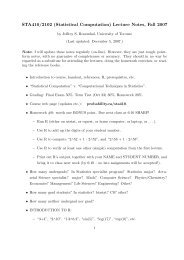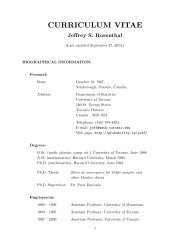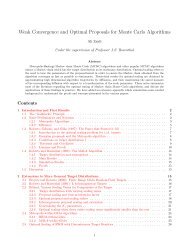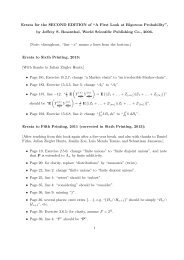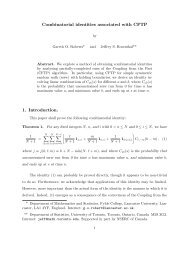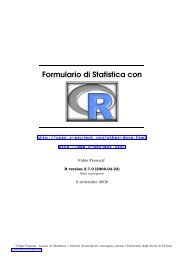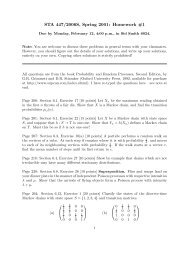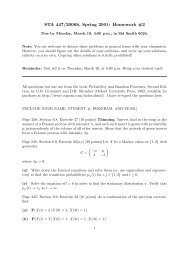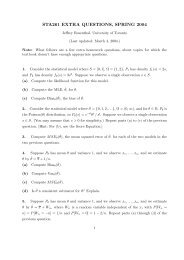Causal Inference: The R package pcalg
Causal Inference: The R package pcalg
Causal Inference: The R package pcalg
You also want an ePaper? Increase the reach of your titles
YUMPU automatically turns print PDFs into web optimized ePapers that Google loves.
20 <strong>Causal</strong> Graphical Models: Package <strong>pcalg</strong><br />
[1] 0.5421360 -0.0049012<br />
One can take summary measures of the multiset. For example, the minimum absolute value<br />
provides a lower bound on the size of the true causal effect: If the minimum absolute value<br />
of all values in the multiset is larger than one, then we know that the size of the true causal<br />
effect (up to sampling error) must be larger than one. <strong>The</strong> fact that the unique values of the<br />
multisets of the global and local method are identical implies that summary measures of<br />
the multiset that only depend on the unique values (such as the minimum absolute value)<br />
can be found using the local method.<br />
In some applications, it is clear that some variable is definitivly a cause of other variables.<br />
Consider for example a bacterium producing a certain substance, taking the amount of produced<br />
substance as response variable. Knocking out genes in the bacterium might change<br />
the ability to produce the substance. By measuring the expression levels of genes, we want<br />
to know which genes have a causal effect on the product. In this setting, it is clear that<br />
the amount of substance is the effect and the activity of the genes is the cause. Thus in the<br />
causal structure, the response variable cannot be a parent node of any variable describing the<br />
expression level of genes. This background knowledge can be easily incorporated: By setting<br />
the option y.notparent = TRUE, all edges in the CPDAG that have the response variable as<br />
endpoint (no matter whether directed or undirected) are overwritten so that they are oriented<br />
towards the response variable.<br />
3.6. idaFast<br />
In some applications it is desirable to estimate the causal effect of one variable on a set of<br />
response variables. In these situations, the function idaFast() should be used. Imagine<br />
for example, that we have data on several variables, that we have no background knowledge<br />
about the causal effects among the variables and that we want to estimate the causal effect<br />
of each variable onto each other variable. To this end, we could consider for each variable<br />
the problem: What is the causal effect of this variable on all other variables. Of course, one<br />
could solve the problem by using ida() on each pair of variables. However, there is a more<br />
efficient way which uses the fact that a linear regression of a fixed set of explanatory variables<br />
on several different response variables can be computed very efficiently.<br />
<strong>The</strong> function idaFast() can be called with the following arguments<br />
idaFast(x.pos, y.pos.set, mcov, graphEst)<br />
<strong>The</strong> arguments x.pos, mcov, graphEst have the same meaning as the corresponding arguments<br />
in ida(). <strong>The</strong> argument y.pos.set is a vector containing the column positions of all<br />
response variables of interest.<br />
Thiscallperformsida(x.pos, y.pos, mcov, graphEst, method="local", y.notparent=FALSE,<br />
verbose=FALSE) for all values of y.pos in y.pos.set at the same time and in an efficient<br />
way. Note that the option y.notparent = TRUE is not implemented.<br />
Consider the example from Section 3.5, where we computed the causal effect of V 2 on V 5 .<br />
Now, we want to compute the effect of V 2 on V 5 , V 6 and V 7 using idaFast() and compare<br />
the results with the output of ida(). As expected, both methods lead to the same results.<br />
R> data("gmI")<br />
R> suffStat pc.fit



